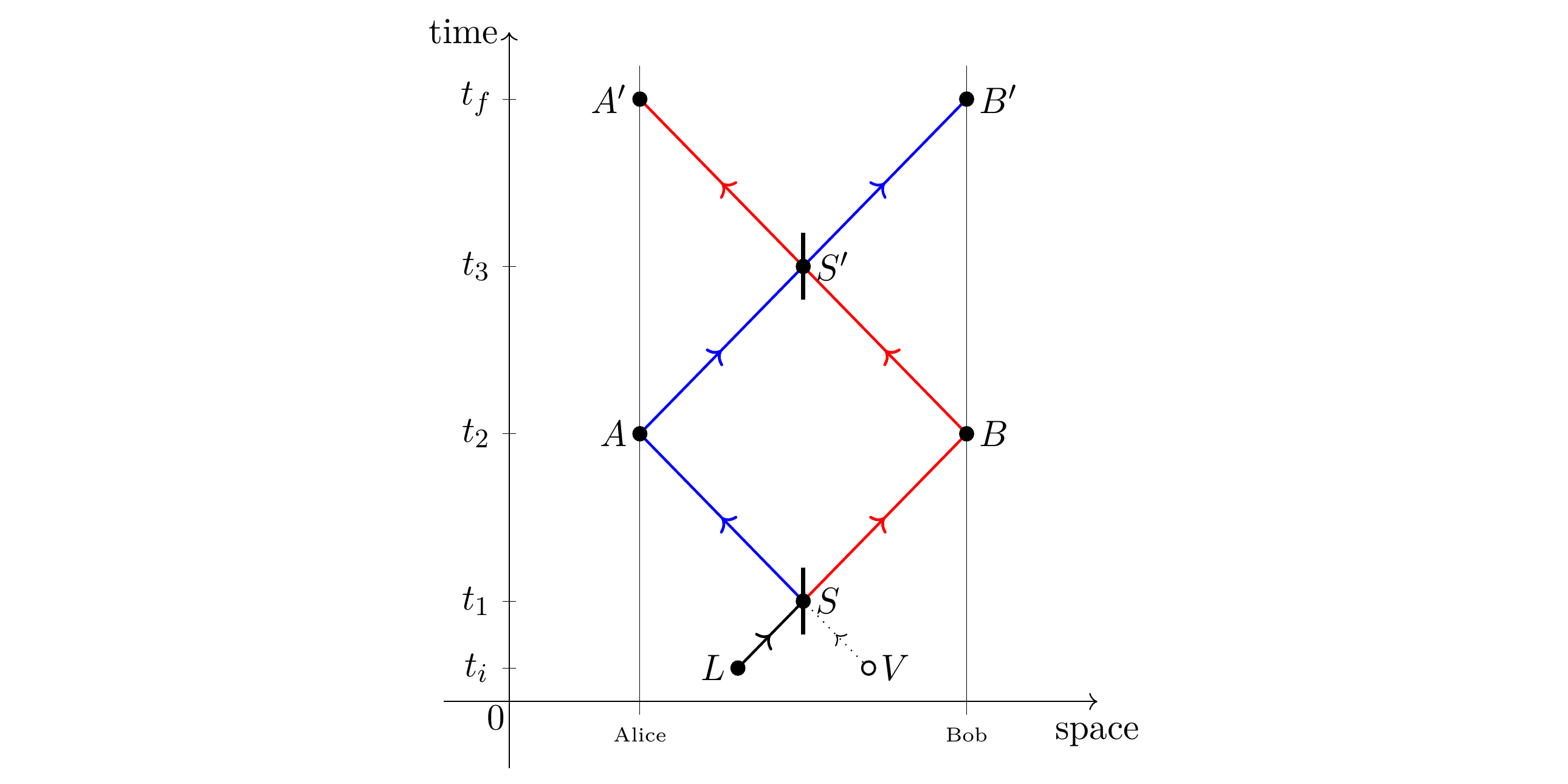1Instituto de Telecomunicações, Avenida Rovisco Pais 1, 1049-001, Lisboa, Portugal
2Departamento de Matemática, Instituto Superior Técnico, Universidade de Lisboa, Avenida Rovisco Pais 1, 1049-001, Lisboa, Portugal
3Institute of Physics, University of Belgrade, Pregrevica 118, 11080 Belgrade, Serbia
Find this paper interesting or want to discuss? Scite or leave a comment on SciRate.
Abstract
This work overviews the single-particle two-way communication protocol recently introduced by del Santo and Dakić (dSD), and analyses it using the process matrix formalism. We give a detailed account of the importance and the operational meaning of the interaction of an agent with the vacuum – in particular its role in the process matrix description. Our analysis shows that the interaction with the vacuum should be treated as an operation, on equal footing with all other interactions. This raises the issue of counting such operations in an operational manner. Motivated by this analysis, we apply the process matrix formalism to capped Fock spaces using the framework of second quantisation, in order to characterise protocols with an indefinite number of identical particles.

Featured image: The spacetime diagram of the process corresponding to the del Santo-Dakić protocol.
► BibTeX data
► References
[1] O. Oreshkov, F. Costa, and Č. Brukner. “Quantum correlations with no causal order”. Nature Communications 3, 1092 (2012).
https://doi.org/10.1038/ncomms2076
[2] G. Chiribella, G. M. D’Ariano, P. Perinotti, and B. Valiron. “Quantum computations without definite causal structure”. Physical Review A 88, 022318 (2013).
https://doi.org/10.1103/PhysRevA.88.022318
[3] M. Araújo, C. Branciard, F. Costa, A. Feix, C. Giarmatzi, and Č. Brukner. “Witnessing causal nonseparability”. New Journal of Physics 17, 102001 (2015).
https://doi.org/10.1088/1367-2630/17/10/102001
[4] J. Bavaresco, M. Araújo, Č. Brukner, and M. T. Quintino. “Semi-device-independent certification of indefinite causal order”. Quantum 3, 176 (2019).
https://doi.org/10.22331/q-2019-08-19-176
[5] P. Allard Guérin, G. Rubino, and Č. Brukner. “Communication through quantum-controlled noise”. Physical Review A 99, 062317 (2019).
https://doi.org/10.1103/PhysRevA.99.062317
[6] L. M. Procopio, A. Moqanaki, M. Araújo, F. Costa, I. A. Calafell, E. G. Dowd, D. R. Hamel, L. A. Rozema, Č. Brukner, and P. Walther. “Experimental superposition of orders of quantum gates”. Nature Communications 6, 7913 (2015).
https://doi.org/10.1038/ncomms8913
[7] G. Rubino, L. A Rozema, A. Feix, M. Araújo, J. M. Zeuner, L. M. Procopio, Č. Brukner, and P. Walther. “Experimental verification of an indefinite causal order”. Science Advances 3, e1602589 (2017).
https://doi.org/10.1126/sciadv.1602589
[8] G. Rubino, L. A. Rozema, F. Massa, M. Araújo, M.a Zych, Č. Brukner, and P. Walther. “Experimental entanglement of temporal order”. Quantum 6, 621 (2022).
https://doi.org/10.22331/q-2022-01-11-621
[9] N. Paunković and M. Vojinović. “Causal orders, quantum circuits and spacetime: distinguishing between definite and superposed causal orders”. Quantum 4, 275 (2020).
https://doi.org/10.22331/q-2020-05-28-275
[10] V. Vilasini and R. Renner. “Embedding cyclic causal structures in acyclic spacetimes: no-go results for process matrices” (2022). arXiv:2203.11245.
arXiv:2203.11245
[11] N. Ormrod, A. Vanrietvelde, and J. Barrett. “Causal structure in the presence of sectorial constraints, with application to the quantum switch” (2022). arXiv:2204.10273.
arXiv:2204.10273
[12] V. Vilasini. “An introduction to causality in quantum theory (and beyond)”. Master’s thesis. ETH. Zürich, Switzerland (2017).
[13] J. Åberg. “Operations and single-particle interferometry”. Physical Review A 70, 012103 (2004).
https://doi.org/10.1103/PhysRevA.70.012103
[14] G. Chiribella and H. Kristjánsson. “Quantum Shannon theory with superpositions of trajectories”. Proceedings of the Royal Society A 475, 20180903 (2019).
https://doi.org/10.1098/rspa.2018.0903
[15] H. Kristjánsson, W. Mao, and G. Chiribella. “Witnessing latent time correlations with a single quantum particle”. Physical Review Research 3, 043147 (2021).
https://doi.org/10.1103/PhysRevResearch.3.043147
[16] F. Del Santo and B. Dakić. “Two-way communication with a single quantum particle”. Physical Review Letters 120, 060503 (2018).
https://doi.org/10.1103/PhysRevLett.120.060503
[17] F. Del Santo and B. Dakić. “Coherence equality and communication in a quantum superposition”. Physical Review Letters 124, 190501 (2020).
https://doi.org/10.1103/PhysRevLett.124.190501
[18] B. Ghosh, A. Mukherjee, and S. Aravinda. “Advantage in two-way communication using non-classical states of light” (2019). arXiv:1904.04596.
arXiv:1904.04596
[19] F. Massa, A. Moqanaki, Ä. Baumeler, F. Del Santo, J. A. Kettlewell, B. Dakić, and P. Walther. “Experimental two-way communication with one photon”. Advanced Quantum Technologies 2, 1900050 (2019).
https://doi.org/10.1002/qute.201900050
[20] C. Portmann, C. Matt, U. Maurer, R. Renner, and B. Tackmann. “Causal boxes: Quantum information-processing systems closed under composition”. IEEE Transactions on Information Theory 63, 3277–3305 (2017).
https://doi.org/10.1109/TIT.2017.2676805
[21] O. Oreshkov. “Time-delocalized quantum subsystems and operations: on the existence of processes with indefinite causal structure in quantum mechanics”. Quantum 3, 206 (2019).
https://doi.org/10.22331/q-2019-12-02-206
[22] M. Araújo, F. Costa, and Č. Brukner. “Computational advantage from quantum-controlled ordering of gates”. Physical Review Letters 113, 250402 (2014).
https://doi.org/10.1103/PhysRevLett.113.250402
[23] L.-Y. Hsu, C.-Y. Lai, Y.-C. Chang, C.-M. Wu, and R.-K. Lee. “Carrying an arbitrarily large amount of information using a single quantum particle”. Physical Review A 102, 022620 (2020).
https://doi.org/10.1103/PhysRevA.102.022620
[24] Y. Zhang, X. Chen, and E. Chitambar. “Building multiple access channels with a single particle”. Quantum 6, 653 (2022).
https://doi.org/10.22331/q-2022-02-16-653
[25] P. Perinotti. “Causal structures and the classification of higher order quantum computations”. Chapter in “Time in Physics”, pages 103–127. Springer International Publishing. Cham (2017).
https://doi.org/10.1007/978-3-319-68655-4_7
[26] A. Bisio and P. Perinotti. “Theoretical framework for higher-order quantum theory”. Proceedings of the Royal Society A 475, 20180706 (2019).
https://doi.org/10.1098/rspa.2018.0706
Cited by
[1] Matthias Salzger, “Connecting indefinite causal order processes to composable quantum protocols in a spacetime”, arXiv:2304.06735, (2023).
The above citations are from SAO/NASA ADS (last updated successfully 2023-04-20 15:47:17). The list may be incomplete as not all publishers provide suitable and complete citation data.
Could not fetch Crossref cited-by data during last attempt 2023-04-20 15:47:15: Could not fetch cited-by data for 10.22331/q-2023-04-20-986 from Crossref. This is normal if the DOI was registered recently.
This Paper is published in Quantum under the Creative Commons Attribution 4.0 International (CC BY 4.0) license. Copyright remains with the original copyright holders such as the authors or their institutions.
- SEO Powered Content & PR Distribution. Get Amplified Today.
- Platoblockchain. Web3 Metaverse Intelligence. Knowledge Amplified. Access Here.
- Minting the Future w Adryenn Ashley. Access Here.
- Source: https://quantum-journal.org/papers/q-2023-04-20-986/



